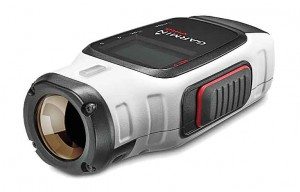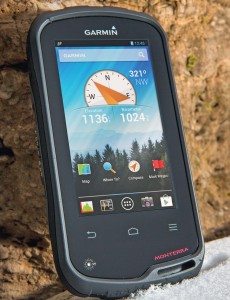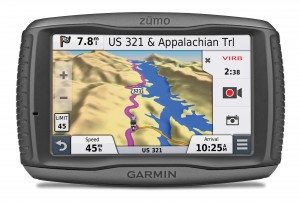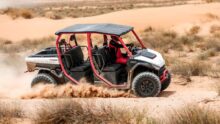Garmin hits the dirt, snow and curvy roads
Company develops GPS and camera devices for powersports applications
Though many may associate Garmin with in-car GPS systems providing turn-by-turn directions or handheld devices designed for hikers, Garmin also has a firm grasp on the powersports industry, developing a variety of products for off-roaders, snowmobilers and motorcyclists.
Garmin was on-hand at this summer’s Western Power Sports Snow Showcase to present its latest products for all segments of the industry.
VIRB

The VIRB and VIRB Elite are part of Garmin’s first-generation line of point-of-view video cameras. The product is designed to go head-to-head with competitors such as GoPro, but the camera has extra features because of Garmin’s GPS roots.
“The big thing that sets us apart is we’re a GPS company, so this Elite has GPS sensors built into it. It’s got Wi-Fi. It’s got an accelerometer. It’s got a barometric altimeter. So basically while you’re filming, you can get all kinds of positional data that you can show on the video. So say you’re skydiving, during the video you can see the speed at which you’re falling; you can see the elevation drop; and you can see your heart rate go up if you’re wearing a heart rate monitor,” explained Brandon Long, inside sales representative for Garmin.
For motorcyclists, the GPS functions can show a rider how many G-forces he or she is pulling on a turn. Or for an off-roader, it can show how much air the rider got off a jump and how that affected speed on the ground. Dealers can also bring the camera to track days, to show customers how to improve their times. And, the data can be overlaid onto the video when published or shown to others.
“There are all kinds of cool info that you normally wouldn’t get on one of these. It really helps you tell the story of your video,” Long said.
The GPS function also allows riders to set the camera, so that it only records when the vehicle is in motion, starting as soon as the vehicle moves and stopping when the vehicle stops.
Though that feature is used to save battery life, Garmin equipped the VIRB with a long-life battery that offers three hours of 1080p shooting or five hours at 720p, with six to seven hours on standby. Also, because the VIRB has a rugged, durable, water-resistant IPX7 shell, it can be hardwired to a vehicle’s battery to conserve power while being used on a vehicle.
“You can mount it on your bike and hardwire power to it, and then you won’t have to worry about the battery at all while you’re riding with it. It will charge while you’re riding,” Long reported.
Though a Dive Case is required for submersing the VIRB in water, the IPX7 shell allows the camera to be exposed to up to 1 meter of water depth for up to 30 minutes without harming the unit.
“It’s waterproof right out of the gate. You can slap it on your helmet and go riding as soon as you bought it, go through a thunderstorm no problems at all,” Long said.
Also setting the VIRB apart from its competitors is its 1.4-inch Chroma display, showing riders exactly what they’re shooting. And the VIRB Elite allows riders to also view the image from their smartphone, offering access to the shot even when the camera is out of reach. And both versions of the VIRB use ANT+ wireless capability to connect to a number of Garmin’s other devices, allowing a user’s GPS to start and stop the camera from the GPS instead of having to touch the VIRB for each clip.
The VIRB also has a 16-megapixel camera, a slide switch for shooting and a camera button for taking still photos. And the camera comes with two universal mounts with interlocking teeth. Helmet, wrist and shoulder mounts are also sold separately.
“Dealers are inevitably going to have customers that say, ‘Well, I’ve go $500 in GoPro accessories already; why should I switch just over battery life and GPS capabilities?’ Well, this actually comes within the box — it comes with a universal mount; it’ll work with any GoPro mount that you may already have anywhere. So they don’t have to completely re-accessorize if they want to try the new camera.”
The VIRB retails for $299.99, but Garmin reports that most customers are willing to pay extra for the $399.99 VIRB Elite.
“WPS is probably 2:1 VIRB Elite over VIRB sales,” Long said.
Montana and Monterra

Just as the VIRB is universal and can be used by all kinds of enthusiasts, so can the Montana and Monterra GPS devices. Though both were designed as handhelds, they can also be mounted to a variety of units, including snowmobiles, side-by-sides, PWC or boats. They can also easily transfer back to a daily driver vehicle.
“These are basically handheld units, but they’ve really come on strong the last year or two with off-road sporting people — snow machines, quads — because it’s got TOPO (topographic) mapping abilities, so you can get elevations, contours of the land, trail mapping. And you can throw it in your car or truck and get turn-by-turn navigation as well, so it’s a true hybrid unit, dual functioning for your truck, your quad, your snow machine. You can put it on your boat; you can load lake view mapping on it, too,” Long said.
For the enthusiast who plans to use the Montana or Monterra on more than one vehicle, mounts that remember settings can be placed on each vehicle, allowing the GPS to easily transition from the street to the trail to the water.
“The different mounts that you can buy for it save all of your data, so you can have it on your snow machine and have it loading TOPO maps; you don’t care about turn-by-turn directions,” Long said. “You just want A to B? Well, you get off your snow machine, take it off, put it in your truck, and it’ll flip over to road maps and all the settings you saved for the truck. So it’s extremely versatile.”
The Monterra, the newer of the two, also has a UV sensor that lets users know of their exposure level to sun, especially at higher elevations, where the exposure is more severe. And it uses the Android operating system, meaning the unit is capable of downloading apps from the Google Play store, many of which have been designed specifically for the Monterra. The Monterra also has an 8-megapixel camera, while the Montana features a 5-megapixel camera.
“You can geotag. You can take a photo with it; it saves the location, share it with your buddy’s unit, and he can navigate to where you took that photo. So you can share trips with people,” Long said.
This feature can be useful for showing fellow hunters how to locate a hunting blind or tree stand, or for showing fellow snowmobilers where the best snow pack lies.
“It’s got a dual battery system, so not only does it do the battery pack, but under the battery pack you can also power it with three AA batteries, too, if you wanted to. So you can really get some extended use out of it,” Long said. “There are lots of ways to keep it going, so you don’t get lost out there.”
The Montana comes in four different versions — 600, 600t camo, 650 and 650t — starting at $469.99, while the Monterra retails for $649.99 and up.
Zumo

Though the VIRB, Montana and Monterra are designed for any vehicle, Garmin’s Zumo GPS units have been developed specifically with motorcyclists in mind.
The Zumo 390LM was the first GPS Garmin created for motorcycling. The most prominent feature that separates it and the premium Zumo 590LM from its automotive counterparts is the Curvy Roads feature, which takes motorcyclists on the scenic routes they often desire.
“I’m not from Minneapolis; this is my first time here. If I wanted to go for a ride, I could now just have it set me on Curvy Roads, and it will actually take you on the scenic route. It used to do just A to B, the quickest way possible, but you didn’t get all the cool scenic views and stuff, and if you’re on the bike, you want to see those things,” Long said. “You can still set the parameters to say no gravel roads, no toll roads, but then you can still have it take you on the Curvy Roads.”
Both motorcycle-focused units are also glove-friendly, allowing riders to use it without removing their gloves. Both units also include a service history log, and they are compatible with Garmin’s Tire Pressure Monitor Sensor.
“It screws right into the valve stem; you just take the valve cap off. You can do up to four tires. You set a threshold of what you want to maintain pressure-wise, and if it drops below it, it will immediately alert you,” Long said. “Even if it was 23.1 PSI, as soon as it hits 23.0, it’s letting you know you need to get back up to the right pressure. It’s just a safety feature. It’s a good upsell. They’re only $70 accessories; that’s for one tire, and you can do up to four tires, if you have a side-by-side or a quad.”
Though the Zumo 390LM is full of motorcycle-specific features, the 590LM delivers even more. The Zumo 590LM has a 5.0-inch screen, compared to the 390LM’s 4.3-inch display, and the 590LM’s screen is sunlight-light readable and has dual-orientation, meaning it can be used horizontally or vertically.
“It’s the best screen we’ve had yet, so basically the brighter it is outside, the brighter the screen becomes, so it’s much easier to see,” Long said. “There was a market for third-party visors for a while there; you don’t have to worry about any of that stuff anymore. The brighter the day is outside, the brighter the screen is. Sunlight bounces through the pixels and makes it really bright.”
The 590LM also has smartphone connectivity and a USB port to keep the phone charged while it’s being used.
“You can tune your phone to it and use your data plan, and you can get Doppler radar; you can get traffic information; you can get traffic cameras; you can stream music to it from your phone — your iTunes or your mp3 player; there’s a Pandora app built into it. So lots of cool features that you can pull from your data plan from your phone,” Long reported.
The 590LM also has wireless capability that allows riders to share favorite routes wirelessly with other 590LM users.
The Zumo 390LM has an MSRP of $599.99, while the Zumo 590LM retails for $899.99.








